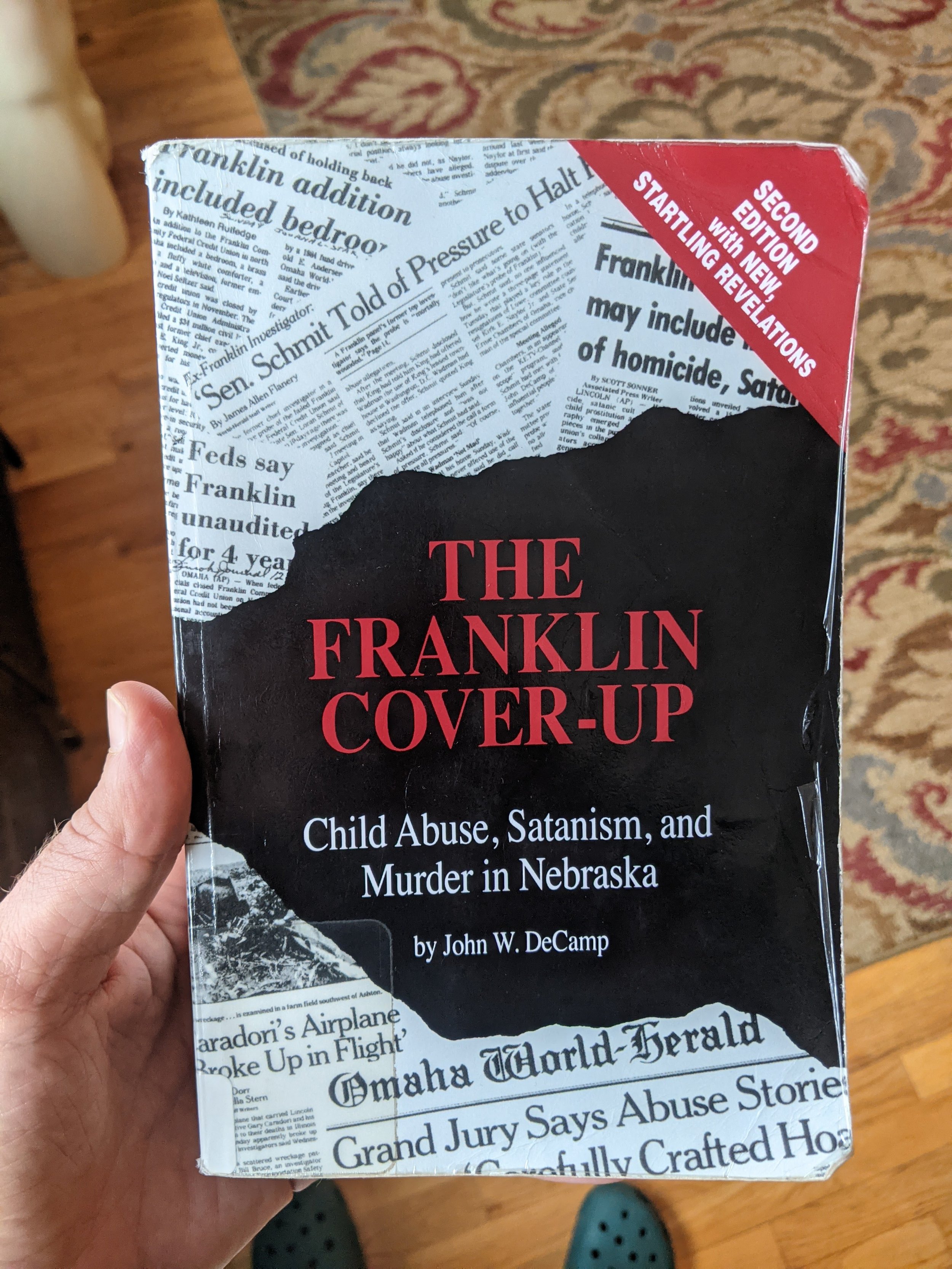THE FRANKLIN COVER-UP: CHILD ABUSE, SATANISM, AND MURDER IN NEBRASKA - JOHN DECAMP
On the Coll-McGowan scale of insanity or outlandishness w/r/t CIA books, this one certainly falls closer to the McGowan end, which might be obvious from the inclusion of the word “Satanism” in the title. The Franklin Scandal is a weird one. It involves 2 interlocking conspiracies and very dark suggestions. The first, which people went to jail over and seems indisputably true, involves a man named Larry King, a Black man who sang the national anthem at the ‘84 and ‘88 Republican conventions and who was rising star in the party, both locally and nationally, who ran the Franklin Community Federal Credit Union and who used that credit union to embezzle funds and live lavishly. That part isn’t too uncommon, people enrich themselves off of money meant for the community every day of the week. The second part, the part that is much more famous and lurid, involves suggestions that King’s real job was acting as a pimp for the Omaha elite, procuring young boys and girls in the foster-care system, including from the famous Boys Town. This part of the conspiracy was emphatically denied and “debunked” and resulted in a number of the child-accusers going to prison for perjury for years, which does seem strange. And that’s only the broad strokes, the accusations and explanations spin out far from there. As the title suggests, there’s a Satanic Panic element, where many of the child-victims report witnessing human sacrifices and other satanic doings. There’s speculation that the bank was being used to launder and move around CIA money that went to the Contras and other less-than-savory recipients. There’s talk of the whole operation being part of a blackmail scheme. All super far-out accusations, wild stuff. While these sorts of stories are interesting to me in and of themselves, the pedigree of this book is what initially drew me to it. John DeCamp is not just some kook, he was a State Senator for a long time in Nebraska. He is himself a Republican and attended events put on by Larry King (with no kid-fucking, he insists). Even more intriguing, he was a life-long friend of former CIA director Bill Colby and actually worked under Colby in Vietnam as part of the genocidal, secretive and profoundly evil Phoenix Program (which, not for nothing, did actually involve killing children). Colby apparently works with DeCamp to uncover some of this stuff before dying very mysteriously himself. Colby’s own son made a movie about how his father killed himself over grief stemming from CIA blackmail operations that involved child prostitution. And Franklin is hardly the only place one finds such accusations. Even as this story was breaking, the press also uncovered the case of Craig Spence, another connected (especially to Donald Gregg, H.W.’s, national security advisor. Spence was able to give child prostitutes midnight tours of the White House) Washington official who was also caught up in accusation of child prostitution, blackmail and intelligence involvement before killing himself as the investigation tightened around him. Obviously, these sorts of accusations can’t but bring Jeff Epstein to mind. I’m prepared to believe that intelligence agencies engage in this sort of behavior, I’d be shocked if they didn’t, however, the satanic stuff is another strange twist that I don’t really have a good explanation for. I don’t think that there’s widespread human sacrifice going on, this seems much harder to cover-up and I don’t see the upside (since I don’t believe in the sort of “Satan” this suggests) for the people who are high enough up to cover-up such activities. Perhaps they push this angel to “shit-coat” the whole operation and make it seem on-the-face ridiculous and laughable to any sane person who hears about it in passing who therefore don’t investigate further or look into it. Is that why the lurid and ludicrous Pizzagate stuff popped up around Epstien’s arrest and “suicide”? Who knows? Otherwise the book has some problems you’d expect from a book written by a republican lawmaker, namely it’s conflating homosexuality with pedophilia and over-indulgence in the Satanism angle. There’s interesting stuff about Omaha/Nebraska politics. Omaha is my birth town but I don’t know anything about it, I’d never heard of the Ak-Sar-Ben society before this. There’s a quick aside about Roy Cohen being involved in similar plots in the 50’s and 60’s which would boost his already stellar villain credentials. DeCamp also relays a story about Hunter S. Thompson using some of the trafficked kids to direct and participate in a snuff film which is not the first time I’ve read about the snuff film rumor w/r/t Hunter Thompson. Who knows? The back half of the book includes chapters on other topics, mostly around the Militia movement in the 90’s, including the Oklahoma City Bombing, which is also a bit all over the place and not very groundbreaking. Apparently the militia folks read the original version of this book and decided they trusted the guy who wrote it so DeCamp became a go-to lawyer in that world. Definitely some interesting stuff in here, like I said, I’d classify it as pretty far out and do think that most of it could be condensed into a longer article. 666 secret plane flights.



















